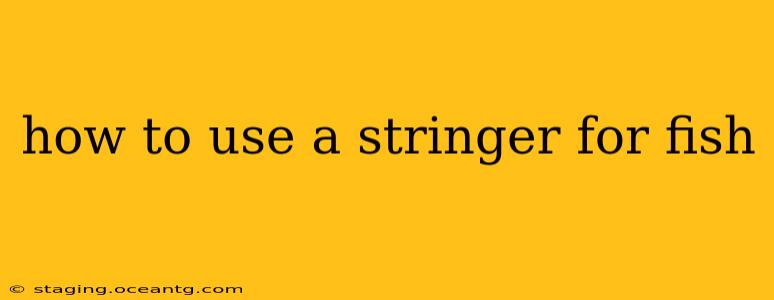Stringers are essential tools for anglers, providing a safe and convenient way to keep your catch organized and fresh. Whether you're a seasoned pro or a beginner, understanding how to properly use a stringer is crucial for ethical fishing and preserving the quality of your fish. This guide will cover everything you need to know, from choosing the right stringer to safely handling and storing your catch.
What is a Stringer?
A fish stringer is a length of strong cord or wire, often with a loop at one end and a hook or clasp at the other. Anglers use it to hold their catch alive in the water while they continue fishing. This keeps the fish fresh and minimizes stress, ensuring they remain in good condition for consumption or release.
Choosing the Right Stringer
Several types of stringers are available, each with its own advantages and disadvantages.
- Wire Stringers: These are durable and strong, capable of holding heavier fish. However, they can cause more damage to the fish's gills and mouth if not used carefully.
- Cord Stringers: These are generally gentler on fish, minimizing potential injuries. However, they might be less durable than wire stringers and may not be suitable for very large or heavy fish.
- Rubber-coated stringers: Combining the durability of wire with the gentler surface of a cord.
Consider the size and type of fish you typically catch when selecting a stringer. A longer stringer allows for more fish, while a shorter one is easier to manage.
How to Use a Stringer: A Step-by-Step Guide
- Gently Hook the Fish: Use the hook or clasp on your stringer to gently hook the fish through the lower lip, avoiding the eyes and gills. A sharp, quick motion minimizes stress and reduces the risk of injury.
- Submerge the Stringer: Immediately submerge the stringer into the water to keep the fish alive and cool. Avoid letting the fish thrash around excessively, as this can cause unnecessary stress and damage.
- Keep the Fish Submerged: Ensure the fish remains submerged at all times, allowing for sufficient water circulation.
- Avoid Overcrowding: Don't overcrowd the stringer. Overloading can lead to suffocation and reduce the overall quality of your catch. Allow ample space between fish.
- Regularly Check Your Catch: Periodically check your catch to ensure they are still alive and well-oxygenated. If you notice any signs of distress, remove the fish immediately.
How to Properly Remove a Fish from a Stringer
- Carefully remove the hook: Use your fingers or pliers to gently remove the hook from the fish's lip. Avoid unnecessary pulling or jerking motions.
- Handle with Care: Support the fish's body to avoid damage.
- Release if Necessary: If you decide to release the fish, ensure it's healthy enough to survive. Handle it quickly and gently and return it to the water as soon as possible.
What are some alternatives to using a stringer?
Some anglers use keep nets or live wells as alternatives to stringers, especially for smaller fish or when multiple people are fishing and want to keep their individual catches separated. These options provide more space and potentially better oxygenation for the fish.
How long can I leave fish on a stringer?
This depends on several factors including the water temperature and the type of fish. Generally, it is best to keep fish on a stringer for as short a time as possible. Ideal scenarios would be keeping the fish for no more than a few hours to maximize their freshness before cleaning and chilling or releasing the fish back into the water.
What are the ethical considerations of using a stringer?
Always use a stringer responsibly. It's important to minimize stress on the fish. If a fish shows signs of distress, remove it from the stringer and either release it or quickly dispatch it humanely. Overcrowding the stringer is unethical and can lead to the death of the fish. Choose a stringer that is appropriate for the size and number of fish you are keeping, and ensure the fish remain submerged.
By following these guidelines, you can ensure you are using a stringer safely and ethically, preserving the quality of your catch and promoting responsible angling practices. Remember, responsible fishing practices are crucial for the health of our waterways and the sustainability of fish populations.
